 Your new post is loading...
 Your new post is loading...
Apple emprunte à son tour la "Verticale du Fou" et abandonne Intel. 3 fois plus performant par Watt dissipé, le processeur "maison" #M1 — annoncé le 10 Novembre dernier — semble confirmer à quel point l'architecture #ARM a réussi à rattraper puis à dépasser l'architecture #X86 du géant de Santa Clara.
Les 16 milliards de transistors du M1 sont en effet gravés en 5 nanomètres, là où Intel ne parvient toujours pas à maîtriser ni 10 ni 7 nanos.
Un excellent article de Tom's #Hardware montre l'étendue de la menace qui pèse désormais sur Intel ; ce n'est pas tant la part de marché du Mac (à peine 9%) que celle de ses développeurs (30%) qui vont de plus en plus exclusivement basculer dans l'architecture ARM.
La une de couverture de The Economist est tombée pile-poil à point pour ma keynote de demain !
Here’s a surprise turn of events: Softbank — maker of the friendly Pepper robot and a major M&A player in the tech world — has just announced that it is acquiring two more robotics companies from Google owner Alphabet as part of its own deeper move into the field: it is buying Big Dog developer Boston Dynamics and the secretive bipedal robotics firm Schaft.A spokesperson for Softbank has confirmed to us that the terms of the deal are not being disclosed, but we will try to find out. In case you are wondering (we were), we have double checked and these are the only two of Alphabet’s robotics companies getting acquired by Softbank.There had been lots of murmurs about Google (and then Alphabet) wanting to offload Boston Dynamics for over a year now. Most recently, Toyota was apparently eyeing up an acquisition of the two businesses.But robots are huge across all of Japan, with some of the biggest innovations, investments, and motivations for developing them coming out of the country; and so, in the end, it looks like another titan of Japanese industry beat Toyota to the punch.“Today, there are many issues we still cannot solve by ourselves with human capabilities,” said Masayoshi Son, Chairman & CEO of SoftBank Group Corp., in a statement. “Smart robotics are going to be a key driver of the next stage of the Information Revolution, and Marc and his team at Boston Dynamics are the clear technology leaders in advanced dynamic robots. I am thrilled to welcome them to the SoftBank family and look forward to supporting them as they continue to advance the field of robotics and explore applications that can help make life easier, safer and more fulfilling.”While Softbank has been hard at work doubling down on big bets in areas that it believes will be at the center of the future of computing — other acquisitions have included its $24 billion acquisition of chip maker ARM Holdings — for Alphabet, this is part of the company’s bigger efforts to rationalise some of its many acquisitions and strategic bets over the years that have not panned out as great fits with the wider business.It looks like the whole team is coming over with the deal. “We at Boston Dynamics are excited to be part of SoftBank’s bold vision and its position creating the next technology revolution, and we share SoftBank’s belief that advances in technology should be for the benefit of humanity,” said Marc Raibert, CEO and founder of Boston Dynamics, in a statement.“We look forward to working with SoftBank in our mission to push the boundaries of what advanced robots can do and to create useful applications in a smarter and more connected world.”When Alphabet (still called Google at the time) acquired Shaft and Boston Dynamics in 2013 (Shaft was purchased as one of a group of seven acquisitions), the company did not disclose the terms of the deals.While Boston Dynamics has been pretty public in posting (sometimes terrifying) videos and generally talking about of its advances in making animal-like robots that can trek across all terrains and get up instantly when knocked over, Schaft has been a fairly quiet presence.Schaft revealed its first big prototypes only about two years after the acquisition. The company has been around since 2012, after being incubated in the JSK Robotics Laboratory at the University of Tokyo by co-founders Yuto Nakanishi, Junichi Urata, Narito Suzuki and Koichi Nishiwaki. It remains a secretive company: an attempted visit to its website today was blocked.
Phytium Technology has announced a 64-core ARM server CPU, which according to the press release will deliver 512 gigaflops of performance.
Japan’s SoftBank is buying U.K.-based chip design firm ARM Holdings for about $32 billion, according to the FT.
Why? Everything is a computer now, and ARM has been one of the winners of the mobile revolution.
ARM designs chips — but doesn’t actually make them — for a huge variety of devices. It dominates the market for smartphones — Apple is a big client, as is Samsung — and its chips shows up in other consumer gadgets, as well as more-industrial-like devices and “internet of things” sensors.
The number of chips containing ARM processors reached almost 15 billion in 2015, up from about 6 billion in 2010.
The move is a big one for SoftBank CEO Masa Son after his would-be successor, former Google executive Nikesh Arora, stepped away from the company last month. (Talks presumably started while Arora was still there.)
One key question is whether other firms will let SoftBank purchase ARM or if there will be a bidding war. Apple, arguably ARM’s most important client, and Intel, which lost the mobile chip war to ARM, are both potential buyers.
The offer is already a generous multiple. As the FT notes, it’s some 70 times ARM’s net income last year. That’s around the same price-to-earnings ratio as Facebook stock.
The Russian government has decided to domestically produce a computer chip which for use in government offices and state-run firms. The move is meant to elbow processors from the likes of AMD and Intel out of government use due to concerns about US spying and processor back doors. Electronics Weekly says Russian President Putin decided to push forward this processor development initiative. It follows a move, four years ago, when the Russian government said that all its computers would be moving to Linux. The Russian processor is currently referred to as the 'Baikal' microprocessor, named after most voluminous freshwater lakein the world. The chip is being designed by T-Platforms, a Russian supercomputer maker, alongside state defence corporation Rostec with co-financing from Russian state-run technology firm Rosnano. The Russian News Agency ITAR-TASS reports that there are going to be two initial Baikal chips; the Baikal M and the Baikal M/S. These chips will be designed upon the foundation provided by the ARM Cortex-A57 64-bit processor and be employed in personal computers and microservers.
According to venture legend John Doerr,Google is designing its own silicon for its data centers. But he stopped short of confirming rumors that the search giant was designing ARM-based chips as was reported in December. Doerr, speaking at a chip conference, also said that Facebook would be next. He’s right. Computing is the primary cost for Google, Amazon Web Services and Facebook and designing their own silicon could lower that cost. And thanks to more modular designs and advances in the ARM architecture, the cost of designing custom chips has fallen into a range where the benefits outweigh design costs.
Scientists have developed a technique to sabotage the cryptographic capabilities included in Intel's Ivy Bridge line of microprocessors. The technique works without being detected by built-in tests or physical inspection of the chip. The proof of concept comes eight years after the US Department of Defense voiced concern that integrated circuits used in crucial military systems might be altered in ways that covertly undermined their security or reliability. The report was the starting point for research into techniques for detecting so-called hardware trojans. But until now, there has been little study into just how feasible it would be to alter the design or manufacturing process of widely used chips to equip them with secret backdoors. In a recently published research paper, scientists devised two such backdoors they said adversaries could feasibly build into processors to surreptitiously bypass cryptographic protections provided by the computer running the chips. The paper is attracting interest following recent revelations the National Security Agency is exploiting weaknesses deliberately built-in to widely used cryptographic technologies so analysts can decode vast swaths of Internet traffic that otherwise would be unreadable.
The goal for a chip maker supporting “Less Than Moore” is not to displace the Qualcomm or Samsung, following Moore’s law and getting back more than enough revenue to invest and develop IC ever more integrated, targeting smaller technology node, supporting the type of Roadmap you can see below. This roadmap from Samsung shows Discrete Application Processor and Baseband Processor paths, as well as in parallel a roadmap for cost sensitive systems with Integrated (Application + BB) processor.
We've been doing significant testing lately with video out using various iOS devices for an upcoming project. In doing so, we waded right in the middle of a strange video out mystery. .../... In short: it appears the Lightning Digital AV Adapter has a SoC ARM CPU with 2Gb worth of RAM
While Apple is now committed to Intel in computers and is unlikely to switch in the next few years, some engineers say a shift to its own designs is inevitable as the features of mobile devices and PCs become more similar, two people said. Any change would be a blow to Intel, the world’s largest processor maker, which has already been hurt by a stagnating market for computers running Microsoft Corp. (MSFT)’s Windows software and its failure to gain a foothold in mobile gadgets.
As handheld devices increasingly function like PCs, the engineers working on this project within Apple envision machines that use a common chip design. If Apple Chief Executive Officer Tim Cook wants to offer the consumer of 2017 and beyond a seamless experience on laptops, phones, tablets and televisions, it will be easier to build if all the devices have a consistent underlying chip architecture, according to one of the people.
Cambridge University researchers find that a microprocessor used by the US military but made in China contains secret remote access capability ...
|
With Graviton2, AWS is making it clear that it is serious about Arm processors in the data center as well as moving cloud infrastructure innovation at its pace. Amazon Web Services launched its Graviton2 processors, which promise up to 40% better performance from comparable x86-based instances for 20% less. Graviton2, based on the Arm architectuare, may have a big impact on cloud workloads, AWS' cost structure, and Arm in the data center. Graviton2 was unveiled at AWS' re:Invent 2019 conference and ZDNet was debriefed by the EC2 team in an exclusive. Unlike the Graviton effort and A1 instances unveiled a year ago, Graviton2 ups the ante for processor makers such as Intel and AMD. With Graviton2, AWS is making it clear that it is serious about Arm processors in the data center as well as moving cloud infrastructure innovation at its pace. "We're going big for our customers and our internal workloads," said Raj Pai, vice president of AWS EC2. AWS is launching new Arm-based versions of Amazon EC2 M, R, and C instance families. Indeed, Graviton2, which is optimized for cloud-native applications, is based on 64-bit Arm Neoverse cores and a custom system on a chip designed by AWS. Graviton2 boasts 2x faster floating-point performance per core for scientific and high-performance workloads, support for up to 64 virtual CPUs, 25Gbps of networking, and 18Gbps of EBS Bandwidth. AWS CEO Andy Jassy said the new Graviton2 instances illustrate the benefits of designing your own chips. "We decided that we were going to design chips to give you more capabilities. While lots of companies have been working with x86 for a long time, we wanted to push the price to performance ratio for you," said Jassy during his keynote. Jassy added that Intel and AMD remain key partners to AWS.
After years of waiting for someone to design an Arm server processor that could work at scale on the cloud, Amazon Web Services just went ahead and designed its own. Vice president of infrastructure Peter DeSantis introduced the AWS Graviton Processor Monday night, adding a third chip option for cloud customers alongside instances that use processors from Intel and AMD. The company did not provide a lot of details about the processor itself, but DeSantis said that it was designed for scale-out workloads that benefit from a lot of servers chipping away at a problem.
Could Samsung be the first big defection from ARM since the SoftBank takeover?
It was always thought that, when ARM relinquished its independence, its customers would look around for other alternatives.
The nice thing about RISC-V is that it’s independent, open source and royalty-free.
And RISC-V is what Samsung is reported to be using for an IoT CPU in preference to ARM.
Now SoftBank made a point of saying that its take-over of ARM was to get into IoT. If Samsung is now going to RISC-V for its IoT CPU, this affects the scale of Softbank’s aspirations and may persuade others to defect to RISC-V.
The Samsung RISC-V MCU is said to be aimed squarely at the ARM Cortex M0.
Nvidia and Qualcomm are already using RISC-V in the development of GPU memory controllers and IoT processors.
Although, as Intel found, it’s almost impossible to replace an incumbent processor architecture in a major product area, which means that ARM’s place as the incumbent architecture in cellphones is secure, at the moment there is no incumbent processor architecture in IoT or MCU – so these are up for grabs by any aspiring rival processor architecture.
Today, ARM Holdings is a $1.5B company with +15% year-to-year growth, nice financials (such as 96.7% Gross Margin), and a 46.7% Operating Margin. (For all the details — perhaps too many — see this 2015 presentation.) 15B ARM-based chips for $1.5B revenue means that, on average, ARM gets a licensing revenue of 10 cents per chip, and spends a little less than of half of that, 4.7 cents, to generate such revenue. It sure beats today’s Windows PC business and its measly 5% to 7% Operating Margins in the best of cases. ARM Holdings is doing well by any measure, but the price paid for an asset is supposed to reflect expectations of future gains. If we compound ARM’s 15% revenue growth over ten years we come up with $6B, a 4x revenue increase…so why is SoftBank willing to pay $32B, more than 20 times current revenue? Masayoshi (Masa) Son, SoftBank’s founder, isn’t a wide-eyed, newly-rich entrepreneur looking to make — or lose — a quick buck. Having built a large PC software business, he diversified into telecoms in Japan and the US (SoftBank owns 80% of Sprint). He also holds a piece of Yahoo! which, if this weekend’s rumors are true, is soon to be rolled into Verizon. Having survived the 2000 dot-com bubble and the 2008 financial crisis with a personal fortune estimated at $17B, Son isn’t shy about criticizing the short-term views of US investors and their fixation on “shareholder value” at the expense of other longer-term metrics and societal contributions. With his accomplishments and maverick attitudes in mind, we must conclude that Son sees many more ARM-based chips in our future, some with a revenue-per-unit that’s higher than today’s 10 cents. But where does he see them?
Iliad, via sa filiale d’hébergement Online.net, va faire son entrée sur le marché du Cloud. Avec un concept en rupture. Des micro-serveurs dédiés basés sur des puces ARM. Et une architecture maison. Online.net, filiale d’hébergement d’Iliad-Free, va lancer un service Cloud simple d’usage et basé sur des serveurs ARM, et non sur des puces x86. Sur le modèle d’un DigitalOcean (hébergeur new-yorkais) connaissant une croissance rapide, l’offre sera disponible selon un modèle tarifaire à l’heure. Elle reposera sur des serveurs dédiés, et non sur une couche de virtualisation, ainsi que sur du stockage SSD. « Ce qui est impressionnant chez DigitalOcean, c’est leur croissance. C’est la raison principale pour laquelle nous avons examiné leur modèle », explique à VentureBeat Yann Léger, le vice-président Cloud Computing d’Online. Publicité Lancé voici environ deux ans, le projet, baptisé Online Labs, doit déboucher à la mi-janvier, avec le lancement commercial de l’offre. La filiale d’Iliad mise sur des puces Cortex A9 développées par Marvell pour offrir des performances optimisées pour les applications Web. La firme explique que son serveur C1, né de ces développements, est plus petit qu’une carte de crédit et consomme seulement quelques watts. « Nous obtenons une meilleure densité qu’avec des serveurs virtualisés et une consommation électrique deux à trois fois inférieure », assure Online. Clairement, Iliad mise sur ces arguments – essentiels dans l’équation économique d’un hébergeur – pour venir perturber le marché du Cloud, où les acteurs dominants comme Amazon et Microsoft testent certes le potentiel des puces ARM (notamment en matière de réduction de la consommation électrique), mais sans franchir le pas.
Fayçal Boujemaa, responsable recherche et développement de Cloudwatt, revient pour Silicon.fr sur l’adoption de l’architecture ARM dans les serveurs. Et ouvre la porte à une diversification des processeurs présents dans les datacenters du Cloud.
is Intel’s new CEO is rethinking the “x86 and only x86″ strategy? Last week, a specialty semiconductor company called Altera announced that Intel would fabricate some if its chips containing a 64-bit ARM processor. The company’s business consists of offering faster development times through “programmable logic” circuits. Instead of a “hard circuit” to be designed, manufactured, tested, debugged, modified and sent back to the manufacturing plant in lengthy and costly cycles, you buy a “soft circuit” from Altera and similar companies (Xilinx comes to mind). This more expensive device can be reprogrammed on the spot to assume a different function, or correct the logic in the previous iteration. Pay more and get functioning hardware sooner, without slow and costly turns through a manufacturing process. With this in mind, what Intel will someday manufacture for Altera isn’t the 64-bit ARM processor that excited some observers: “Intel Makes 14nm ARM for Altera“. The Stratix 10 circuits Altera contracts to Intel manufacturing are complicated and expensive ($500 and up) FPGA (Field Programmable Gate Array) devices where the embedded ARM processor plays a supporting, not central, role. This isn’t the $20-or-less price level arena in which Intel has so far declined to compete.
An impressive explosion in speed: In the six years since the original iPhone was released, the speed of the iPhone has increased by 40X. The iPhone 5S alone is a doubling in speed over the iPhone 5.
ARM processors are used mostly in smartphones, but Boston Limited is offering a service through which developers can port existing x86 applications to work on ARM servers, which can then be tested via a cloud service.
It seems not too long ago that the storage industry was fragmented in terms of the "compute" layer in their storage systems. PowerPC, MIPS, Sparc and other platforms dominated the "pie chart" with x86 occupying a small share. Then something happened - all suppliers moved to x86 as a premise for commoditization of the storage platform. With vendors like Dell now testing low-powered ARM based servers and ARM releasing a 64-bit architecture, the question is how long before ARM becomes the platform of choice for storage vendors?
Apple thankfully didn't obscure the details of its A6 slide at the launch event, which gave us a Samsung part number: K3PE7E700F-XGC2. Through crafty navigation of Samsung's product guide, Brian Klug got us the details. The K3P tells us we're looking at a dual-channel LPDDR2 package with 32-bit channels. The E7E7 gives us the density of each of the two DRAM die (512MB per die, 1GB total). The final two characters in the part number give us the cycle time/data rate, which in this case is 1066MHz.
|
 Your new post is loading...
Your new post is loading...
 Your new post is loading...
Your new post is loading...






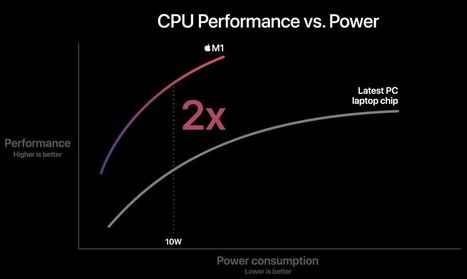

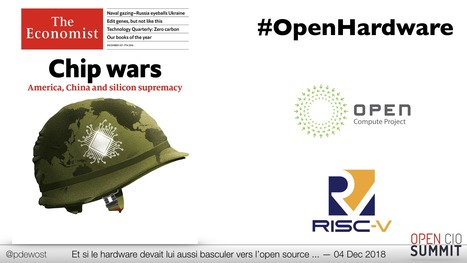


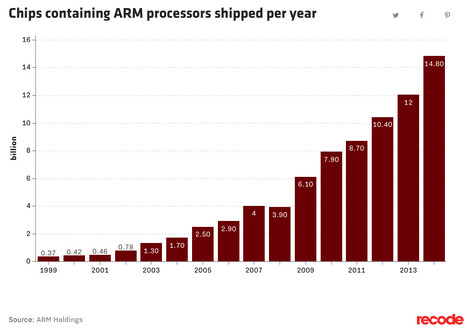



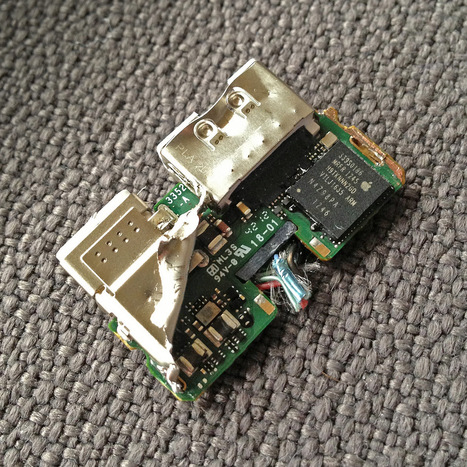

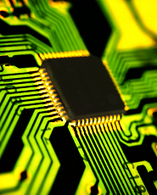

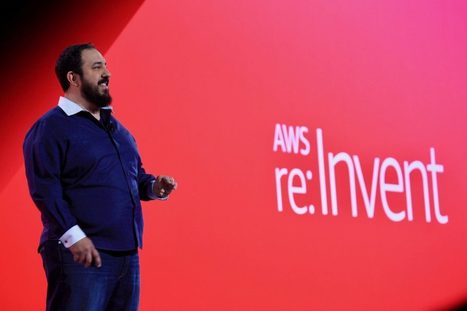


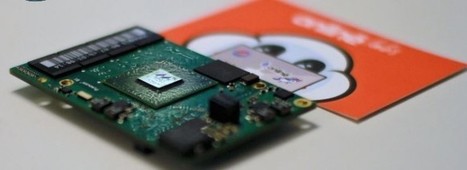


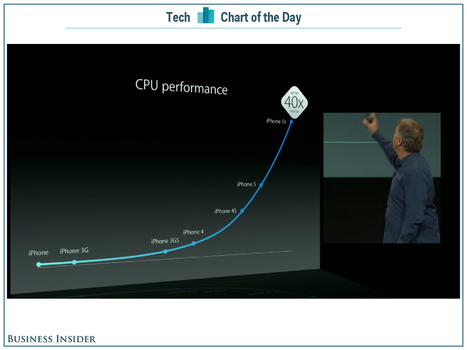








L'intégration verticale est la tendance "Tech" du moment...